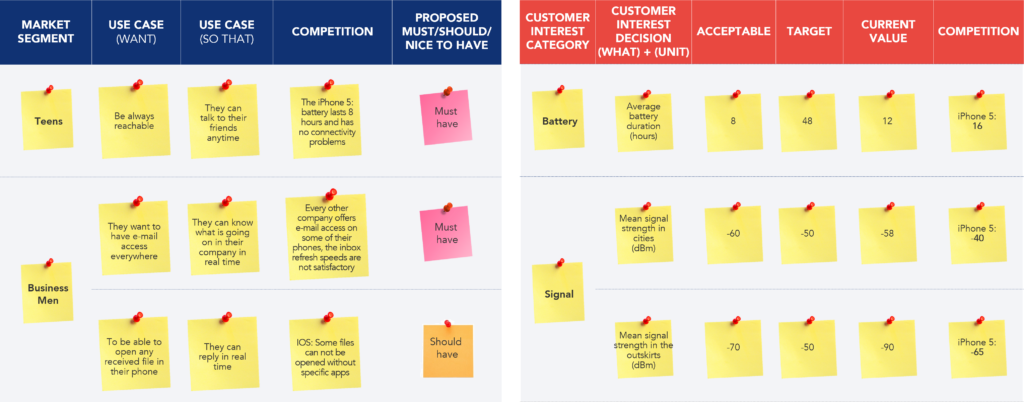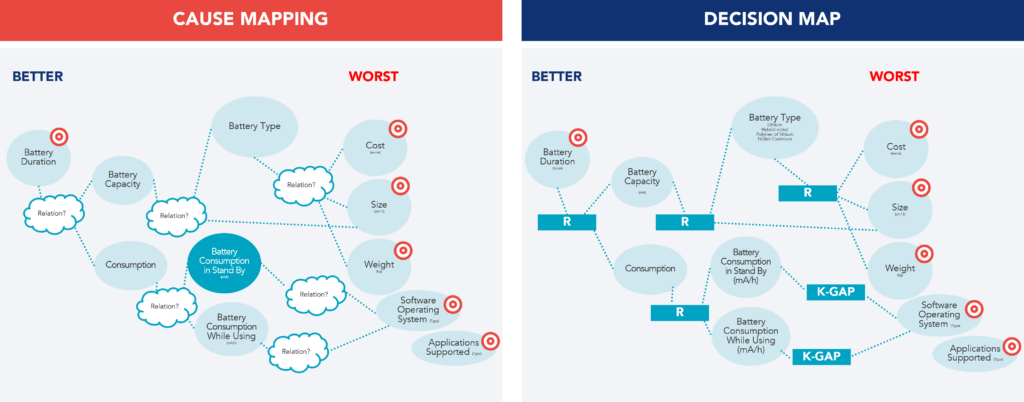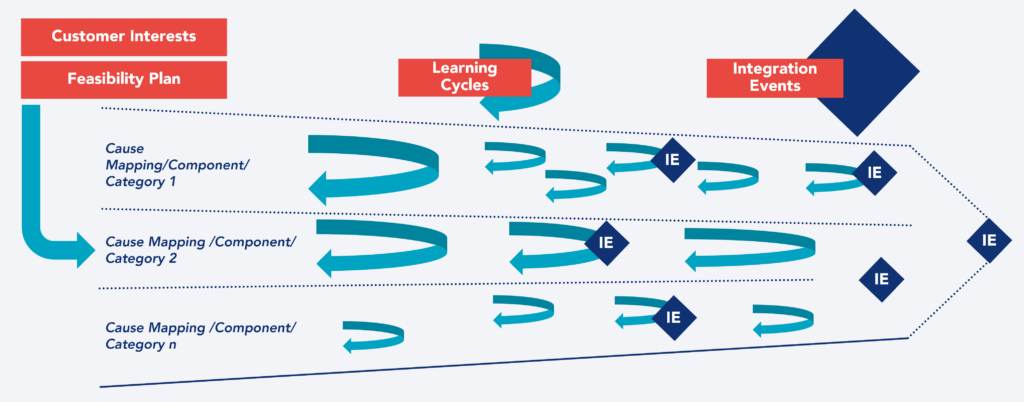The search for innovative solutions in lean product development represents a multifaceted challenge. Finding the ideal combination that meets the company’s objectives, satisfies customer interests, and is within technical capabilities is a complex journey. This article explores an approach known as Set-Based Engineering (SBE), a methodology that aims to overcome the traditional limitations of product development.
SBE stands out as a promising approach, ensuring success by clearly identifying customer interests and conducting learning cycles before the design phase. This article examines the fundamentals of this methodology, exploring how it is possible to transform challenges into opportunities, providing a solid framework for developing innovative and efficient products.
Product Development Challenges
The initial phase is fertile ground for various challenges in the product development process. Crucial decisions are affected by uncertainty at this stage, and customer objectives often remain vague.
In this context, this uncertainty is a temporary state and a persistent challenge that can generate crucial dilemmas. Poor clarity in customer requirements and gaps in technical knowledge become significant obstacles. The traditional approach, in which a single solution is selected without thorough exploration, becomes prone to failure, resulting in prototypes that do not meet project goals and systems that do not function correctly during usage and integration tests.
The Decisive Role of Initial Choices
Decision-making in the concept phases not only shapes the future path of the project but also has a tremendous influence on outcomes. Studies reveal that decisions made in these early stages determine between 70-85% of the total product costs. Only a modest portion of research and development (R&D) investments (8-15%) is allocated to this critical period.
Moreover, companies face the disturbing reality that a substantial proportion of their R&D capacity, between 60-75%, is consumed by rework resulting from inaccurate initial decisions. The mismatch between the significance of early decisions and the effort put into making them underscores the need for more robust methods and strategies to address these challenges.
These obstacles in the initial phase of product development are not just temporary, as they end up impacting the entire product life cycle.
The Wright Brothers’ “Test-then-Design” Method
The history of system design is marked by significant milestones that have shaped how we conceive and develop products. A crucial chapter in this evolution is represented by the “Test-then-Design” method of the Wright Brothers, aviation pioneers. This innovative method divided the complex challenge of flight into three critical areas representing knowledge gaps: lift, control, and propulsion.
By independently focusing on these areas, the Wright Brothers adopted a focused and iterative approach, pioneering the unknown territory of flight with method and experimentation. By learning what was necessary to support their success, even before embarking on the design of the aircraft, they achieved a solid foundation for developing complex systems. This approach of testing and learning before progressing to design not only secured the flight’s success but also set the stage for future methods in system design.
As the inherent challenges in product development became more complex, the need for more flexible and adaptable approaches arose. The transition from the traditional paradigm to Set-Based Engineering represents a significant milestone in this evolution.
Introduction to Set-Based Engineering
Truly understanding what customers want is a recurring challenge. Additionally, deepening this understanding reveals uncertainty about how feasible it is to meet customer expectations. However, companies are willing to act as quickly as possible to achieve these goals.
Iterative and Incremental Flow of Decisions and Work
At the heart of Set-Based Engineering (SBE) is creating a flow of decisions and work that is iterative and incremental. This is reached by using Trade-off Curves and understanding how they causally interact.
Trade-off curves visually represent the product’s physical and economic processes. These curves are a primary tool for engineers, as is the case at Toyota, for use on various fronts, from understanding and communicating between areas and functions to training new engineers. On top of that, they form the foundation for organizing and documenting knowledge, facilitating negotiation and communication between customer and supplier, conducting design reviews, and incorporating greater quality into the product.
The central goal of SBE is to minimize noise, such as resistance to progress, resulting in more informed and effective decisions. The Toyota approach involves conducting exhaustive tests of these curves until multiple prototypes fail. This principle is known as set-based thinking, where the emphasis is not on capturing a single point but entire sets of solutions.
Acquired Knowledge Available for Other Projects
SBE operates on multiple fronts to visualize, understand, and solve knowledge gaps. By adopting SBE, companies are able to meet customer requirements and accumulate valuable knowledge for future projects. The emphasis on the Set-Based Thinking approach allows organizations to explore solutions, providing a solid foundation for informed decision-making and continuous innovation in product development.
Benefits of Set-Based Engineering
Set-Based Engineering offers a range of tangible benefits for adopting companies. This section explores the benefits it provides, highlighting how this methodology transforms uncertainty into advantages.
Risk Mitigation and Improvement in Decision-Making
The Set-Based Engineering approach allows teams to better identify and understand challenges before making final decisions by creating an environment where multiple solutions are explored and iteratively tested. This results in more informed decision-making and significantly reduced uncertainty, mitigating potential failures that could arise later in the development cycle.
Continuous Innovation and Organizational Learning
By adopting the set-based thinking mindset, teams are encouraged to identify and resolve knowledge gaps. This results in more effective solutions and develops organizational knowledge, creating a solid foundation for future innovations.
Improvement in Communication and Collaboration
The trade-off curves used in SBE serve as decision-making tools and improve communication and collaboration within and between teams. The clear visualization of the product’s physical and economic processes facilitates mutual understanding, promoting a collaborative and effective environment. This is crucial for design optimization and effective communication with customers and suppliers.
Dynamic Adaptation to Changes in the Business Environment
SBE allows for dynamic adaptation to changes in the business environment. The flexibility of the approach facilitates a rapid response to changes in customer requirements, technological evolutions, and market conditions. This positions companies strategically to face constantly evolving challenges and stand out in competitive environments.
In summary, set-based engineering disperses inherent challenges in product development and provides a holistic approach that drives efficiency, innovation, and organizational resilience.
Set Based Engineering Steps
Set Based Engineering (SBE) is an approach that guides product development through a series of carefully planned steps. Each phase is designed to maximize understanding of customer needs, identify and resolve technical knowledge gaps, learn iteratively, and ultimately integrate solutions to reach an optimal conclusion.
Customer Interests
In this initial stage, we focus on a detailed visualization of customer requirements and knowledge gaps, using Customer Interest Boards to ensure meeting needs and preferences.
Objectives
- Deep understanding of customer needs: explore customers’ motivations and expression modes in detail.
- Selection of needs to be met: decide which customer needs should be prioritized.
- Transformation into measurable units: convert these needs into quantifiable units, establishing specific values and goals.
- Knowledge of limitations and trade-offs: understand the constraints and trade-offs between various customer interests.
- Organization in customer interest boards: structure and organize this information clearly and visually.
Deliverables
- Case studies for each market segment: initially understand what stakeholders want, why they want it, and how.
- Competitor positioning: assess the strategies adopted by the competition.
- Priorities of interests to be addressed: make informed decisions about which interests will be prioritized.
- Customer interest categories: identify and classify the different customer interest categories.
- Decision variables: identify the decision variables associated with each customer interest.

Feasibility Planning
We focus on feasibility planning in the second phase, where customer interests are connected to technical decisions. We use the Alternative Matrix and the Cause Mapping to identify and address gaps in technical knowledge.
Objectives
- Strategic connection between customer interests and technical decisions: establish an effective link between customer interests and fundamental technical choices.
- Identification of relationships among technical variables, limits, and trade-offs: analyze and understand the interrelationships among technical variables and associated limitations and trade-offs.
- Listing of gaps in technical knowledge: identify the gaps in technical knowledge existing within the organization.
- Definition and planning of tests to address gaps: develop a plan with actions, dates, and responsible parties to resolve and implement technical knowledge gaps.
Deliverables
- Alternatives matrix: document the direct relationship between customer interests and relevant technical decisions.
- Cause mapping: visually establishes the possible relationships between customer interests and technical decisions, identifying critical connections.
- Decision map: transform the cause mapping into a structured decision map, providing a clear and ordered view.
- Identification of knowledge gaps: map the organization’s unknown relationships and missing areas of knowledge.
- Feasibility planning board: plan the technical decisions and associated work packages, providing a framework for efficiently executing activities.

Learning Cycles
In the third phase, the Learning Cycle, the focus shifts to resolving previously identified knowledge gaps. Typically, the LAMDA cycle addresses them, promoting continuous improvement and accelerating product development through proactive learning in the initial phase.
Objectives
- Defining the problem and learning objectives: clarify the underlying problem and establish clear learning goals.
- Detailed study with LAMDA cycles:
– Look: observe and analyze the context and the variables involved.
– Ask: formulate crucial questions for a deeper understanding.
– Model: create models that effectively represent the problem.
– Discuss: conduct collaborative discussions to explore different perspectives.
– Act: implement concrete actions based on the conclusions reached.
- Constructing prototypes to test components related to knowledge gaps: develop prototypes to evaluate practical solutions for the gaps identified.
- Testing and evaluating results: conduct rigorous testing on prototypes, assessing their effectiveness and filling knowledge gaps.
- Documenting acquired knowledge: comprehensively record the lessons learned and knowledge gained throughout the process.
Deliverables
- Study (using the LAMDA Cycle): document the “Look, Ask, Model, Discuss, and Act” stages, highlighting the learning process.
- Prototype: develop and present prototypes that directly address the identified knowledge gaps.
- Tests: evaluate the prototypes, validate the proposed solutions, and summarize the findings in the Testing Board.
- Knowledge summaries / Trade-off curves: document the information obtained, including trade-off curves, and extract the lessons learned to guide future decisions.
Integration Events
The final phase, known as Integration Events, focuses on merging the knowledge acquired in previous phases with the selection among competing alternatives based on that knowledge.
Objectives
- Selecting competing alternatives based on visible knowledge: use the acquired knowledge to choose among the available competing alternatives.
- Eliminating less robust solutions: discard less effective solutions, focusing on optimization and selection.
- Achieving an optimal solution within the time limits and established budget: ensure that the final choice is as advantageous as possible, considering time and financial resources.
- Reducing the design space without compromising product features: refine the scope or design space, focusing on the product’s essential characteristics.
- Standardize decisions and stakeholder involvement: establish decision-making standards and involve stakeholders to ensure alignment and consensus.
Deliverables
- Knowledge review: achieve consensus on the outcomes obtained during the ongoing Learning Cycle, ensuring that the knowledge is fully understood and accepted.
- Preparation for integration events: organize information and insights from the Learning Cycle to prepare for the integration phase.
- Intermediate integration events: analyze available alternatives, define the new design space, and consider the underlying implications of each option.
- Final integration event: evaluate customer satisfaction regarding feasibility alternatives and select the optimal final solution, considering all relevant factors.
- Decision on the optimal solution: make an informed and collective decision on the solution that best meets the requirements, consolidating the choices made throughout the process.

Organizations can fully capitalize on the benefits of set-based engineering by addressing each step with diligence and creating innovative, efficient products aligned with customer expectations.
Conclusion
In the challenging landscape of product development, where the quest for innovation is constant, complexity lies in balancing business objectives, customer expectations, and technical capabilities. By adopting set-based engineering, organizations address inherent challenges in product development and create a solid foundation for making informed decisions and ensuring continuous innovation. By fully embracing the benefits of SBE, companies are positioned to thrive in a dynamic and competitive environment.
Still have questions about Set Based Engineering?
What is a Trade-off Curve?
A Trade-off Curve is a visual representation that illustrates the relationship between two or more variables, highlighting their trade-offs. This curve helps us understand how changes in one variable affect another and vice versa. In product development, Trade-off Curves are essential for making informed decisions and balancing different aspects of the project.
What is the LAMDA Cycle?
The LAMDA Cycle is a structured approach to problem-solving and continuous learning. Each letter represents a stage in the process:
- Look: carefully observe the context and variables involved.
- Ask: formulate crucial questions for a deeper understanding.
- Model: create models that effectively represent the problem.
- Discuss: conduct discussions to explore different perspectives.
- Act: implement concrete actions based on the conclusions reached.
The LAMDA Cycle is a valuable tool for studying complex problems, developing iterative solutions, and documenting learning throughout the process. This cycle is often used in contexts of innovation and addressing challenges in product development.
See more on Lean Product Development
Find out more about improving this business area
